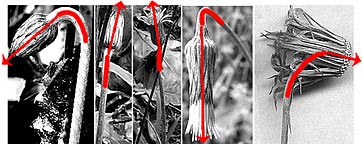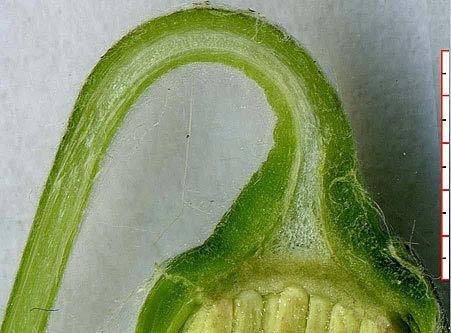
 Series of peduncle/head orientations from bud to dispersal: open–head type (left) & closed–head type (right)
Series of peduncle/head orientations from bud to dispersal: open–head type (left) & closed–head type (right)
Chaptalia texana Nodding and Peduncle Anatomy: Speculation
by Bob Harms


Only c. 4 mm of the peduncle, just below the head, actually bend/straighten. (Longitudinal section of open–type head at dispersal.)
In examining the shape of the receptacal — described for Chaptalia (Nesom, FNA) as "receptacles flat to convex" — I noted that the upper (convex) peduncle wall (cortex) was significantly thicker than the lower wall over the critical nodding portion, but above & below that section this asymmetry did not exist. (I also noted that the receptacal was slightly concave at anthesis, never flat.) I found this to be true of all closed–head types.
 Longitudinal section of closed–type receptacle and upper peduncle.
Longitudinal section of closed–type receptacle and upper peduncle.


 [Click to enlarge.]
[Click to enlarge.]
I found no evidence of this asymmetrical cortex thickening with open–head types. However, at the time I began to pursue the notion that the thickening played a role in the nodding habit, I no longer had access to fresh peduncles for the open–head type. I will not be able to confirm this view until next spring (2011).

Longitudinal section of open–type peduncle bend area.
[Click to enlarge.]
Speculative Scenario to Account for the Nodding Series
- With bud formation, the peduncle is flexible and bends under the weight of the bud.
- As the peduncle grows it is no longer bowed by the bud. However, the cortex of the closed–head peduncle begins to thicken on the upper side, the side that gets the most light.
- Both types exhibit some degree of heliotropism with early anthesis and this pulls the head upward. The effect is greater on the open–head peduncle which has not thickened and remains flexible; the head approaches an erect position.
- As the achenes develop, the heavier head again weighs the peduncle apex downward. The open–head peduncle again nods, c. 115–145°. But with the closed–head the asymmetrical cortex growth continues, and this, together with the increased head weight, creates a bend of ±180°.
- The head & peduncle dry prior to dispersal. The relatively thick cortex at the base of the head shrinks, pulling the somewhat concave receptacle into a convex form. As the peduncle gradually dries (i) the cortex stiffens toward a straight position and (ii) the weight of the head lessens. The interaction of these two factors brings the head back upward. A heavier head (e.g., with more achenes, as with the open–head type) would not straighten as much. The cortex asymmetry of the closed–head type could mean that the shrinking of the thicker cortex wall would exert greater force toward an erect position, counteracting the weight of the head. [For a comparison of the peduncle/head orientation at dispersal.]
Plant Resources Center Home Page — Flora of Texas
— Chaptalia texana






